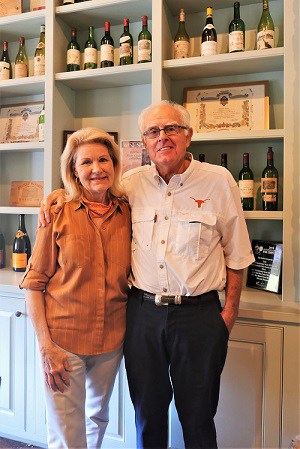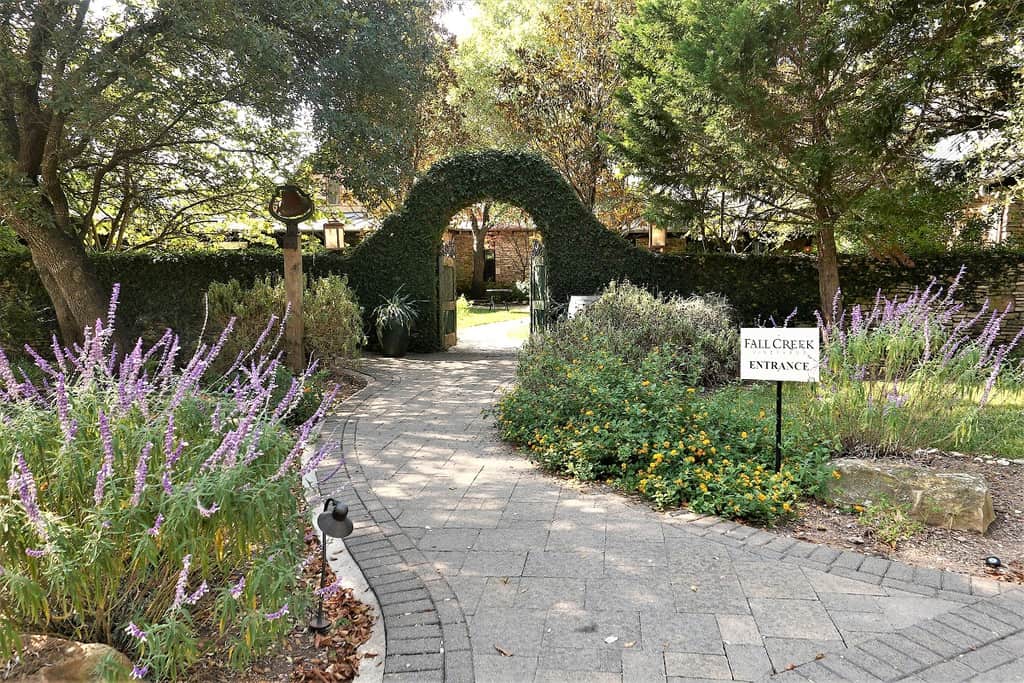Fall Creek Vineyards now has two different locations in Texas where Winetravelers can visit and taste their world-class wines. Their Tow location was the first and is part of the Fall Creek Ranch that Ed Auler inherited after law school. Their sons are the fifth generation in the ranch lineage.
In Driftwood, approximately a 30-minute drive west of Austin, Winetravelers have the opportunity to taste on the grounds, or grab a bottle or two to take across the street to the famous Salt Lick BBQ, which is a must-eat location in the Texas Hill Country area. The Salt Lick BBQ is BYOB and allows diners to bring local wine, or beer, onsite to enjoy with some of the best Texas BBQ around. In fact, many of the grapes used in Fall Creek Vineyards’ wines come from vines owned by Salt Lick and will be labeled on the bottles as “Salt Lick Vineyards.” The two family-owned businesses have a longstanding partnership in agriculture and wine.
RELATED: Download the Free Winetraveler App To Find Wineries & Travel Itineraries Around The World
Winemaker, Sergio Cuadra, is an industry professional who celebrates his eighth vintage with Fall Creek Vineyards in 2020. The wines made under his watch are simply phenomenal. Whatever one may think about the quality, or lack thereof, of Texas wines, Fall Creek Vineyards will surely outpace expectations.
From dry Loire-style Chenin Blanc to Reserva-quality Tempranillo; Merlot rosé to Bordeaux blends and GSMs, Fall Creek Vineyards offers consumers a taste of how excellent Texas wine can be when done right.
Don’t leave the Texas Hill Country without a visit to one of Fall Creek Vineyards’ locations and have a taste of true Texas terroir-driven wines.
RELATED: Top Wineries To Visit in Texas Hill Country
What To Expect Wine Tasting in Texas Hill Country
On an average warm, sunny Hill Country day, you will find guests sitting all around the garden-style property in Driftwood, just outside of Austin, sipping on Chenin Blanc, Chardonnay, or perhaps a Tempranillo. The tasting room inside has a homely comfort about it, complete with a fireplace and TV for football-watching. This is Texas, after all, and football is king, so it only makes sense that a winery owned by two University of Texas alums would have a TV for Saturday games.
Out on the back porch of the charming country house-converted-into-winery, tables are spaced out for groups to sit and wait for a table-side tasting, which has been the program since the beginning for tastings at Fall Creek Vineyards’ Driftwood location. Guests can sit and order wine from the tasting list, which is then brought to them as they enjoy the scenery of the Texas Hill Country landscape around the property from the comfort of their seats on the porch.
RELATED: Learn About Visiting Fall Creek Vineyards
Fall Creek Vineyards, owned by Ed and Susan Auler, has a rich history in Texas’ famed Hill Country wine region. In fact, the winery was the first in the modern Texas Hill Country wine industry. In true Texas spirit, Ed and Susan pioneered their way through industry doubters, regulators, and nay-sayers to build a lasting premium winery in a part of the country where there were none at the time.
Rooted in Time and Place in the Texas Hill Country
The slogan for Fall Creek Vineyards is “Rooted in Time and Place in the Texas Hill Country,” and you learn that is certainly true when you sit down and talk with Ed and Susan. Their focus is on Texas terroir-driven wines, using grapevines rooted in Texas dirt from specific vineyards with influence and inspiration from many of the world’s greatest French and Spanish wines.
In the early days, they worked with industry legacies like Andre Tchelistcheff, and they have consulted with the likes of heavy hitters like Paul Hobbs. Their winemaker, Sergio Cuadra, is Chilean and has led some of the biggest winemaking operations in that country, such as Concha y Toro and Caliterra. Though the name dropping doesn’t hurt in a business dominated by labels, Ed and Susan don’t need to call out their personal Rolodex of wine industry stars at every meeting; their wines speak for themselves.
Texas Vinifera & The Founding of an AVA
Back in the early days, the Aulers were told that vinifera vines wouldn’t grow in Texas. The climate is too hot, and the soil isn’t quite right. Instead of listening to the voices saying no, Ed and Susan just decided to go ahead and plant. They planted hybrid vines in 1975, which were the first vines planted in the modern era of Texas wine. In 1979, they celebrated their first vintage, and by 1980, Ed had quit practicing law to pursue his wine industry aspirations full time. In 1982, the Aulers had planted Cabernet Sauvignon and Chenin Blanc and were working closely with Andre Tchelistcheff, who was an early supporter of their winemaking venture. With Ed’s background in law, he began to draft laws and legislation with regards to winemaking in Texas, as these industry regulations did not exist before this time.

They were the first in the state to plant Tempranillo in 1988, and at the same time were working tirelessly to form the first Texas AVA. In the 80s, Texas was bursting on the culinary scene with the Southwest Food Movement, and it seemed like the prime time to elevate Texas wines, too. The Aulers took the opportunity that time and place presented to them through their connections in the culinary world with those who appreciated home-grown Texas wine.
Though commonplace now, making the case for forming an American Viticultural Area (AVA) in the 1980s was no easy task. Ed and Susan applied, but were told they needed to explain the uniqueness of the region, and that it had to be a known viticultural region, which it was not. Instead of accepting defeat, Susan took it upon herself to build the case for Hill Country as a viticultural region through the founding of the Texas Hill Country Food & Wine Festival, which she started in 1986. If the world would recognize the uniqueness of the food and wine from this region, surely, it wouldn’t be long before the area was known as a place for growing vines and making wine. Her creativity and Ed’s legal expertise paid off in the end with the establishment of the Texas Hill Country AVA in 1991, now the third-largest and southernmost AVA in the country.
